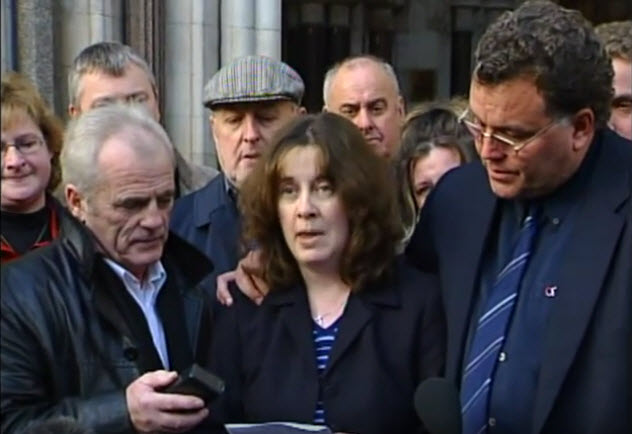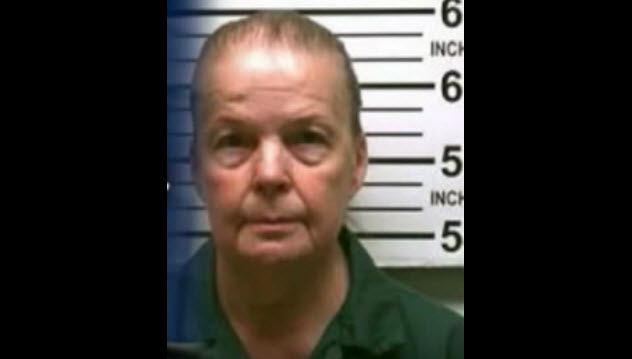 Our World
Our World  Our World
Our World  Pop Culture
Pop Culture 10 Incredible Female Comic Book Artists
 Crime
Crime 10 Terrifying Serial Killers from Centuries Ago
 Technology
Technology 10 Hilariously Over-Engineered Solutions to Simple Problems
 Miscellaneous
Miscellaneous 10 Ironic News Stories Straight out of an Alanis Morissette Song
 Politics
Politics 10 Lesser-Known Far-Right Groups of the 21st Century
 History
History Ten Revealing Facts about Daily Domestic Life in the Old West
 Weird Stuff
Weird Stuff 10 Everyday Products Surprisingly Made by Inmates
 Movies and TV
Movies and TV 10 Actors Dragged out of Retirement for One Key Role
 Creepy
Creepy 10 Lesser-Known Shapeshifter Legends from Around the World
 Our World
Our World 10 Science Facts That Will Change How You Look at the World
 Pop Culture
Pop Culture 10 Incredible Female Comic Book Artists
 Crime
Crime 10 Terrifying Serial Killers from Centuries Ago
Who's Behind Listverse?

Jamie Frater
Head Editor
Jamie founded Listverse due to an insatiable desire to share fascinating, obscure, and bizarre facts. He has been a guest speaker on numerous national radio and television stations and is a five time published author.
More About Us Technology
Technology 10 Hilariously Over-Engineered Solutions to Simple Problems
 Miscellaneous
Miscellaneous 10 Ironic News Stories Straight out of an Alanis Morissette Song
 Politics
Politics 10 Lesser-Known Far-Right Groups of the 21st Century
 History
History Ten Revealing Facts about Daily Domestic Life in the Old West
 Weird Stuff
Weird Stuff 10 Everyday Products Surprisingly Made by Inmates
 Movies and TV
Movies and TV 10 Actors Dragged out of Retirement for One Key Role
 Creepy
Creepy 10 Lesser-Known Shapeshifter Legends from Around the World
10 Shocking Cases Involving Munchausen Syndrome By Proxy
Munchausen syndrome by proxy (MSBP), also known as factitious disorder, is when a caregiver, usually the child’s mother or a female close to the child, fabricates a child’s illness. In extreme cases, the person causes the child to actually become sick, often with dire and sometimes fatal consequences.
The individual enjoys the attention and sympathy that she receives for having a sick child as well as the praise for being such a devoted mother. In the United States, 2.5 million cases of child abuse are reported annually. It’s estimated that 1,000 of those cases involve MSBP.
The women on this list were all accused of harming or even killing their children, with MSBP to blame. However, MSBP has proven to be an extremely controversial diagnosis, with some psychiatrists arguing that it is overdiagnosed and may not even exist as a syndrome.
10 Sally Clark

The tragic case of Sally Clark began in 1996 when her 11-week-old son, Christopher, suddenly died. On the evening of December 13, Clark, who was home alone with Christopher, put him to bed. When checking on him a few hours later, she found him unconscious. Christopher was pronounced dead at the hospital. The cause of death was believed to be a breathing problem.
About a year later, Clark gave birth to her second son, Harry. She found him unconscious in his bouncy chair when he was eight weeks old. Again, Clark was home alone with her son when it happened. Investigators became suspicious, thinking it was not possible that two babies could have died in the same manner. A month later, Clark was arrested for murdering her two sons.
The prosecution relied heavily on testimony by Sir Roy Meadow, a famed British pediatrician and expert on MSBP. According to Meadow, the deaths fit the criteria of factitious disorder. He testified that the odds of two babies in the same home dying of sudden infant death syndrome (SIDS) were 1 in 73 million. The prosecution painted Clark as a lonely drunk who resented her children because she had to give up her high-paying job as a lawyer to stay at home. Clark was convicted in 1999, receiving life in prison.
During her second appeal in January 2003, her conviction was overturned when it became known that Meadow had made a mistake in his calculations and the pathologists had failed to turn over a report showing that Harry had suffered from a bacterial infection, meaning that he had probably died of natural causes.
Clark was unable to recover from the incident. She died on March 16, 2007, from acute alcohol poisoning. Both Meadow and the pathologist were sanctioned by the General Medical Council for serious medical misconduct. Meadow was taken off the medical register, but he was reinstated a year later. The pathologist was banned from Home Office pathology and coroner work for three years.
9 Lisa Hayden-Johnson

Lisa Hayden-Johnson’s son, whose name has not been released due to legal reasons, was born prematurely in 2001. As a result, he needed medical attention, which included a feeding tube. Hayden-Johnson loved the attention and sympathy she received from having a sick child so much that when her son began getting better, she fabricated an elaborate con that he was gravely ill.
Appearing on television, she told everyone that her son had a life-threatening food allergy that left him unable to eat and caused him to have a tube inserted into his stomach. If that wasn’t enough, she also stated that he was confined to a wheelchair due to cerebral palsy and cystic fibrosis. Her lies were so believable that her son actually thought that he was sick. She had the doctors convinced as well, resulting in the young boy having unnecessary operations.
Hayden-Johnson earned national attention with her story. Donations from the public poured in, including money, a new car, and a cruise. Her son received a Children of Courage award and met Prime Minister Tony Blair and his wife at the event. The mother and son also met Camilla, Duchess Of Cornwall.
The con lasted six years. In 2007, a pediatrician reviewed the boy’s medical file and became suspicious that his health problems had lasted so long without a clear diagnosis. He ordered more specific tests to be conducted. On the day that it was to happen, Hayden-Johnson reported that she had been sexually assaulted. When interviewed by police, her deceptive scheme unraveled. She was arrested and pled guilty to child cruelty and perverting the course of justice. She was sentenced to three years and three months in prison.
8 Kathy Bush
By the time Jennifer Bush was eight years old, she had been hospitalized over 200 times and had undergone more than 40 medical procedures. She had suffered a weakened immune system, digestive issues, and seizures. As a result of her medical issues, her appendix, gallbladder, and some of her small intestine had been removed.
Nurses became suspicious because young Jennifer always seemed to get worse after visits with her mother. One nurse even reported seeing Kathy Bush inject her daughter in the mouth with a syringe. Officials began an investigation of Kathy but were unable to gather enough evidence against her. Kathy was eventually arrested in 1996 after another nurse filed a complaint.
Within days after her mother’s arrest, Jennifer was transferred to another hospital that specialized in feeding disorders. Shockingly, with her mother absent, Jennifer was able to eat, and doctors determined that she could have her feeding tube removed. Jennifer was placed in foster care, where she began to get better.
In 1999, Kathy was convicted of aggravated child abuse. She served three years of a five-year sentence. She was also forbidden from having contact with her daughter.
In 2005, when Jennifer was 18, the ban was lifted at her request, and she was permitted to see her mother again. Jennifer now says that she doesn’t believe that her mother abused her. Jennifer’s family maintains that her health had already started to improve before she was taken from their care.
In a written statement to the Sun Sentinel in early 2015, Jennifer wrote:
The 10 years I spent in foster care were traumatic, and I had some devastating things happen to me. [ . . . ] Today, I can proudly say my family is extremely close knit. We have flourished despite the devastating separation. The bond I had with my brothers, prior to being removed from my family, is something that never changed. My relationship with them helped carry me through my years in foster care. My parents and I have picked up from where we left off, and have a very close and loving relationship.
7 Lacey Spears
In the short five years that he lived, little Garnett Spears was plagued with health issues, spending much of his time in the hospital. He suffered from constant digestive issues, fevers, seizures and ear infections. He also had to have a feeding tube inserted into his stomach.
His mother, 25-year-old former nursing student Lacey Spears, took to social media to chronicle her son’s health issues, voicing her worry and frustration. Thousands of people soon rallied behind this poor young mother with the sick little boy.
In January 2014, Garnett was once again admitted to the hospital where it was determined that he had dangerously high sodium levels. The hospital became suspicious, alerting the police and Child Protective Services (CPS). As her son was lying in his hospital bed in tremendous pain and slowly dying, Spears spent much of her time on Facebook and her blog, posting a play-by-play, relishing the attention she was receiving. On January 22, Garnett was declared brain-dead. His mother took him off life support the following day.
During a search of the family home, police found an open container of sea salt and two feeding bags which later tested positive for sodium. Lacey was arrested and charged with manslaughter and second-degree murder. In April 2015, she received a sentence of 20 years to life, with the judge stating that MSBP had caused Lacey to crave the attention that being the mother of a sick child gave her.
6 Leslie Wilfred

Leslie Wilfred and her husband, Chris, were married in 2007. A year later, the happy couple was expecting twins.
On November 10, Leslie called Chris from the hospital with a bizarre and heartbreaking story. She had given birth four months early, and the twins had been stillborn. She then said that she’d had the twins cremated and wanted to plan the funeral when she left the hospital.
The family was already under investigation by CPS. Nathan, Chris’s son from a previous relationship, had a history of aggression, violence, and making threats against his family. A few weeks prior to the stillbirths, the police were called to the family home when Nathan threatened them with a knife. This incident also warranted a visit by CPS. When CPS found out about the stillbirths, they contacted the police. That’s when the horrible truth was revealed: Leslie had never been pregnant.
An initial police investigation revealed that she’d had her tubes tied after the birth of her last child, years before she had married Chris. She had also ordered two teddy bear urns five days before the supposed stillbirths. Police then seized all medical records and conducted a search of the home.
It was revealed that Leslie had fabricated medical illnesses for two of her four children and had been abusing Nathan. She had told everyone that her 13-year-old son, Charles, needed a liver transplant. Then her nine-year-old daughter, Theresa, was dying of leukemia. The community even set up donation boxes to help out the family. Both stories were lies. However, the most disgusting act was committed against Nathan. He was forced to sleep in a tiny wooden box with plastic bands on his arms to prevent him from moving. As a result, the poor boy suffered from PTSD, which actually caused him to have those violent outbursts.
Leslie was convicted of cruelty to children and theft by deception. She was sentenced to eight years in prison. Once released, she will be on probation for 30 years. Although Chris maintains that he had no idea about his wife’s deception, he was convicted on one count of cruelty to children. He went along with Leslie in allowing Nathan to sleep in a box. Both parents were ordered not to have contact with their children unless it was granted by the court.
5 Angela Cannings

In 2002, Angela Cannings was convicted of murdering her two sons, seven-week-old Jason who passed away in 1991 and 18-week-old Matthew who died in 1999. She was sentenced to life in prison. Angela always maintained her innocence, stating that her sons had died of sudden infant death syndrome, just like her 13-week-old daughter, Gemma, who passed away in 1989.
As in the case of Sally Clark, the prosecution relied on the testimony of Sir Roy Meadow at Angela’s trial. In 1977, Meadow announced his discovery of a new form of child abuse where mothers harmed or killed their children for attention. He named it “Munchausen syndrome by proxy.” He later came up with what he called “Meadow’s Law,” which stated that one cot death is a tragedy, two is suspicious, and three is murder. It was his expert testimony that helped secure Angela’s conviction.
During Angela’s appeal, it was revealed how inaccurate the testimony of Meadow really was. Geneticists testified that it was more likely that an undiscovered genetic disorder had killed Jason and Matthew and that Angela had not smothered them, as Meadow had stated during the trial. It was also revealed that her great-grandmother and grandmother had also had children who died in the same manner. Another expert testified that factors such as smoking, food allergies, and the position in which the baby slept increased the risk for a SIDS death.
After reviewing all the new testimony, the judges stated that Meadow’s testimony was manifestly wrong, grossly misleading, and should come with a health warning attached to it. Angela’s conviction was overturned in 2003 after she had already served 20 months of her sentence. Her story was turned into a BBC movie called Cherished.
As for Meadow, his reputation was destroyed. Several of the women he gave testimony against later had their convictions overturned when it was revealed that he gave inaccurate and misleading information and statistics. Some described him as being on a witch hunt, seeing MSBP in every case that he reviewed. He eventually retired from the medical profession. But the question remains: How many innocent women were convicted based on his testimony or by other doctors who followed his theories?
4 Blanca Montano

In February 2011, Blanca Montano rushed her two children to the hospital as both were exhibiting flu-like symptoms. Testing determined that both children had E. coli. Although her son was treated and released after making a full recovery, her five-month-old daughter began getting worse.
The little girl was transferred to intensive care. For the next two months, she contracted up to nine different bacterial infections. She would develop one, have it treated, get better, and then develop another one. A laparoscopic surgery and bone marrow biopsy were conducted. Doctors were unable to determine a cause for all of these infections. Soon, hospital staff became suspicious, suspecting Montano of having MSBP. A camera was installed in the hospital room, monitoring Montano for several days.
Montano was observed playing with her daughter’s IV line and then covering the camera lens. Hospital officials now believed that they had proof of their suspicions. The police and CPS were contacted, and the child was placed in CPS custody. With Montano unable to visit, the little girl began to get better, eventually making a full recovery.
Montano was arrested and charged with one count of child abuse. The prosecution alleged that the young mother was looking for attention and to win back the affections of the child’s father. During the trial, a nurse testified to having found syringes in the mother’s purse. A social worker told the court that Montano expressed surprise that no one had called CPS earlier. Montano was found guilty and sentenced to 13 years in prison. She maintains her innocence and plans on appealing her conviction.
3 Kelly Savage

Kelly and Buddy Savage had three happy and healthy children. Other than the occasional tummy ache or flu, their kids didn’t have any medical problems. Their fourth child, Austin, wasn’t so lucky. At one week old, he fell ill with pneumonia, requiring him to be put in an incubator. Things only became worse when he returned home. He was not able to keep any food down, causing him to be underweight. He also cried constantly.
Kelly brought her son to the hospital, where doctors determined that the cause of his illness was severe acid reflux. According to the doctors, Austin’s acid reflux was so severe that he would feel the same pain as someone suffering a heart attack. Austin had to undergo surgery and have a feeding tube inserted. He was also put on a special formula. None of it seemed to work. By the time he was nine months old, he weighed the same as a child half his age.
In 2004, Austin was once again admitted to the hospital, only this time his room was outfitted with a video camera. The camera recorded Kelly taking formula out of his feeding bag. Fearing MSBP, the hospital staff notified CPS. Kelly stated that she had noticed an air bubble blocking the feeding tube and thinking it would make Austin sick, she removed some of the formula.
Austin was immediately placed in foster care. However, his medical condition remained the same, even though his mother was no longer allowed to see him. Although most people would have realized at that point that Kelly was not harming her son, she was arrested anyway and charged with child abuse. Her trial only lasted two days. Expert testimony not only disproved the theory of MSBP but proved that little Austin really was suffering from medical issues. In 2005, Kelly was fully exonerated.
2 Marybeth Tinning

As we’ve already seen, there is often a rush to judgment when a mother has a sick baby or the child dies in her care. However, in the case of Marybeth Tinning, it took 14 years and nine dead babies for people to become suspicious.
This tragic tale began in 1971 when Marybeth’s eight-day-old daughter, Jennifer, died of spinal meningitis. Perhaps Marybeth snapped, overcome by grief at the loss of her newborn or perhaps she enjoyed the sympathy that she received at the loss, but Marybeth soon began killing all of her children.
Less than a month after Jennifer’s death, her son Joseph Jr. passed away. Marybeth had brought him to the hospital saying that he’d had a seizure. He was released two days later. Hours after his release, his lifeless body was brought back to the hospital. Marybeth stated that she’d found him dead in his crib. A few weeks after that, her daughter Barbara began convulsing and was rushed to the hospital where she passed away the following day.
The now childless Marybeth decided to have more children. In November 1973, her son Timothy was born. He died less than a month later. It was the same story as Joseph Jr. She had found the boy dead in his crib.
Next came the deaths of Nathan, Mary Frances, Jonathan, and her adopted child, Michael. They all had had seizures or suddenly stopped breathing. Once again, Marybeth was childless.
Her ninth child, Tami Lynn, was born in August 1985. It was only after her death in December that police decided to investigate. Under questioning, she admitted to having smothered Timothy, Nathan, and Tami Lynn.
Due to lack of evidence, Tinning was tried only for the death of Tami Lynn. She was convicted and sentenced to 20 years to life. She was denied parole four times. In early 2015, her most recent parole was also denied.
1 Beverley Allitt
Beverley Allitt was a nurse at Grantham and Kesteven Hospital. Over a two-month period in 1991, four children who were in her care died, and several others became dangerously ill.
The first death was seven-month-old Liam Taylor who was admitted to the hospital with a chest infection. Under Allitt’s care, he went into respiratory distress twice. After the second occurrence, he was left alone with Allitt. It was during this time that he went into cardiac arrest, causing him to be placed on life support. After receiving medical advice that their son would not recover, Liam’s parents had him taken off life support. His cause of death was determined to be respiratory failure.
Two weeks later, 11-year-old Timothy Hardwick also died after being left alone with Allitt. Timothy had cerebral palsy and was admitted to the hospital after suffering an epileptic seizure. Although officials were unable to determine his cause of death, it was suspected that epilepsy was the cause.
Three days after the death of Timothy, Allitt found her next intended victim, one-year-old Kayley Desmond, who was suffering from a chest infection. After a visit from Allitt, the girl went into respiratory distress. She was able to be resuscitated. After she was transferred to another hospital, doctors noticed an odd puncture wound under her armpit. It was not investigated.
More victims followed, either dying or coming close to it. It was only after the April 22 death of 15-month-old Claire Peck that a hospital consultant, Dr. Nelson Porter, became alarmed and decided to launch an investigation. After running tests, he found a high amount of potassium in Clair’s blood. This discovery resulted in her body being exhumed, which led to the drug lignocaine being found in her system. Although the drug is used when a patient goes into cardiac arrest, it’s never given to children.
Allitt was arrested and charged with four counts of murder, 11 counts of attempted murder, and 11 counts of causing grievous bodily harm. During the trial, it was revealed that Allitt had spent most of her younger years faking illness, often wearing casts and bandages in a bid for attention. Experts testified that she suffered from MSBP. She was sentenced to 13 concurrent sentences of life imprisonment with the judge imposing a minimum term of 30 years, meaning that Allitt can be released in 2022.
This case brought MSBP to the forefront, causing the Royal College of Pediatrics and Child Health to make recommendations that doctors receive guidance on how to handle suspected cases.








